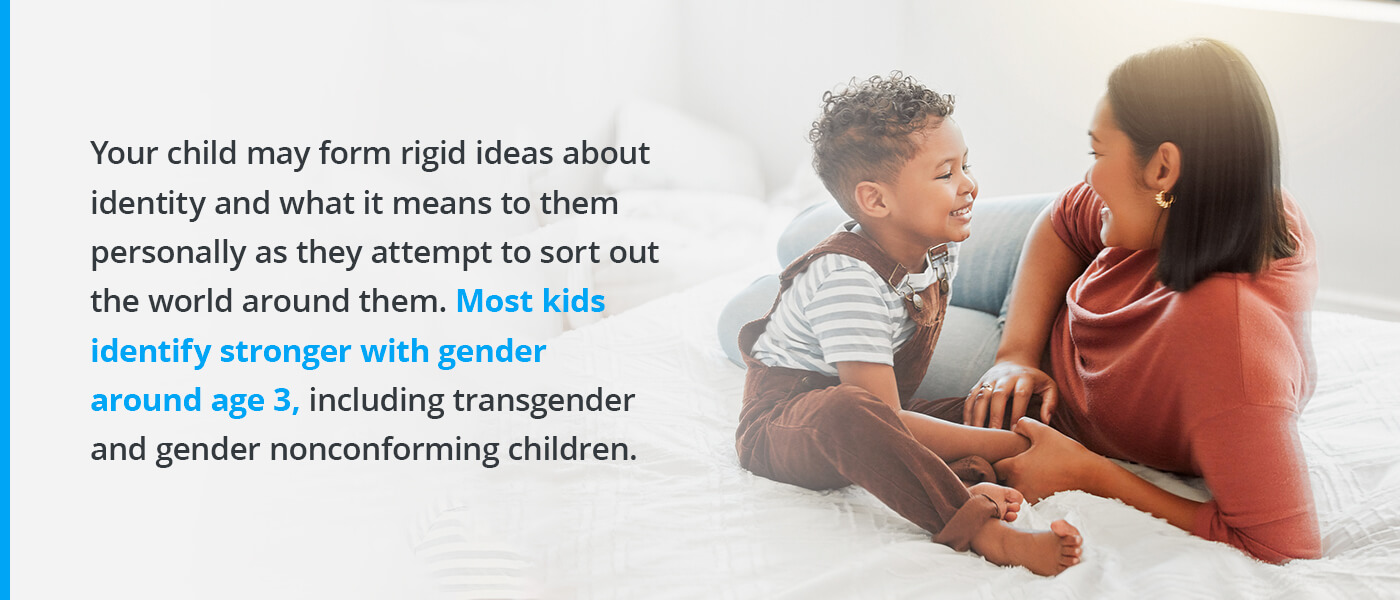Talking to your child about sexual orientation and gender identity can seem overwhelming. You may feel unsure about the best time to discuss the topic or even how to start the conversation. However, discussing these topics can signal that you are open and ready to listen to and accept your child, regardless of whether they identify as LGBTQ+.
Children start identifying with their gender early on and often have questions about sexual identity from a young age and through high school. Creating a supportive space for your child during these years can ensure they feel confident, resilient, loved and authentically themselves. Here’s how to talk to your child about gender identity and sexual orientation during different stages of life.
Talking to Young Children About Sexual Identity
Your child begins picking up messages about gender and sexuality from the day they’re born. In many ways, society tells us how boys and girls are supposed to look, dress, speak and act. Your child may form rigid ideas about identity and what it means to them personally as they attempt to sort out the world around them. Most kids identify stronger with gender around age 3, including transgender and gender nonconforming children.
Even if your child hasn’t given much thought to gender or sexual identity, it can be helpful to broach the subject to create a welcoming space if they have questions in the future.
Here’s how to talk to kids about sexual identity and related topics:
- Make teachable moments out of observations: Young children comment on most things as they observe their surroundings and the children and adults around them. For instance, your kid might notice a child in preschool who has a different kind of family than them, such as parents in the LGBTQ+ community. These moments can inspire thoughtful conversations. Explain to your child that they are right that other families may be different than theirs but that there is nothing wrong with that.
- Lead with compassion and respect: When you talk about gender identity or related topics around your child, lead your discussions with kindness and respect. Let your child know that it’s OK to befriend people who are different from them. Encouraging dialogue about gender roles or sexual orientation may steer them toward respecting others as they grow up. It can also help them accept themselves as they grow older.
- Steer clear of stereotypes: It’s essential to avoid stereotypical or harmful phrases around your child, especially when they are very young. Avoid reinforcing gender roles and using phrases like “be a man” or “act like a lady,” for example. Use the words you really mean, such as brave or polite.
Talking to Middle Schoolers About Sexual Identity
In your child’s preteen years, they’ll likely better understand who they are in relation to others. They might compare themselves to peers, older teens and famous people. At the same time, their unique interests will start to show, whether via hobbies, music or what they want to look like. Most preteens also begin to figure out who they’re attracted to and may question or explore their sexual orientation.
Here’s how to talk to middle schoolers about sexual identity:
- Educate yourself: If your child is unsure about critical terms, educate yourself so that you can confidently provide answers. Learn more about the terms sexual orientation, gender identity, transgender, queer or cisgender mean, for instance. Education can foster compassion about these topics and ensure your child better understands themselves and those around them.
- Gauge how much they already know: Gauge how much your child knows and what questions they want to discuss. It helps to let your child guide conversations so they can ask whatever is on their mind. The discussion doesn’t have to be a major talk. You might broach the subject lightly and encourage ongoing dialogue.
- Provide space: It’s also possible your child isn’t ready to discuss their gender or sexual identity. They might not feel comfortable opening up, which is OK. Just showing your compassion and letting them know you are there for them when they’re ready can go a long way in making them feel loved and understood.
- Show support no matter what: All preteens need encouragement and support as they attempt to figure out who they are. Younger members of the LGTBQ+ community especially need compassion at this stage, with studies showing children in the community were eight times more likely to report attempting suicide when dealing with rejection from family. To support kids who are questioning, explicitly let them know that you love, accept and stand by them.
Talking to High Schoolers About Sexual Identity
No matter your child’s age, it’s essential to be respectful and open about conversations related to gender and sexual identity. As they near high school age, they might better understand themselves and their views on these topics. They may identify as a member of the LGBTQ+ community, struggle with feelings of coming out or have friends in the community.
As a parent, the best thing you can do is let your child know you will always support them, no matter their gender identity or sexual orientation. Conversations may seem tough for you, but they are often more challenging for children. Here’s how to talk to high schoolers about sexual identity and gender:
- Share information: As mentioned, educating and openly sharing information can help your child better understand sexual orientation, gender identity and related topics. You might inform them about specific terms or use resources like books, articles and websites to help them learn more.
- Promote empowerment: When you talk about sexual identity and related topics with your teen, remind them of your values and why they’re important to you. Everyone deserves love and respect, regardless of their sexual orientation or gender identity. Speak out against discrimination such as homophobia or transphobia so your child knows how to stand up for themselves and others.
- Avoid assumptions: Avoid assuming your child’s sexual orientation or pressuring them to conform to societal norms. Let them explore and discover their own identity at their own pace. If your high schooler is not ready to share their sexual orientation or identity with you, respect their privacy and give them the time and space they need to feel comfortable.
- Seek out resources: Remember, talking to your high schooler about sexual identity is an ongoing conversation that may evolve over time. Be open, supportive and respectful of your child’s identity and seek out additional resources or support if needed. There are many ways to support your child, whether through advocacy, awareness or counseling.
Contact Merrimack Valley Psychological Associates for Professional Guidance
While you might not feel confident in addressing topics about gender or sexual identity, that’s OK. For now, it’s crucial that you let your child know they are unconditionally supported, and they can also turn to you to talk about their identity. Even if you don’t have the right words, your child can understand compassion, trust, openness and love.
Trust Merrimack Valley Psychological Associates for guidance and support. Our team of experienced therapists is dedicated to creating a safe and inclusive space for all clients, regardless of sexual orientation or gender identity. We offer a range of therapy services tailored to the specific needs of LGBTQ+ young adults and can educate parents on how to talk to children about these topics.
To learn more about our services, contact us today.



